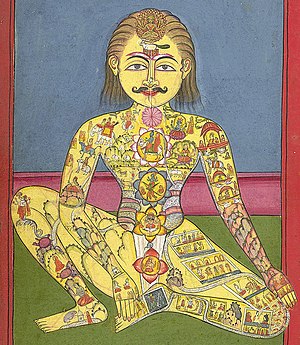
Back Chakra Afrikaans Chakra AN شاكرا Arabic تشاكرا ARY Çakra Azerbaijani چاکرا AZB Чакра Byelorussian Чакра Bulgarian চক্র (যোগশাস্ত্র) Bengali/Bangla Txakra Catalan
This article has multiple issues. Please help improve it or discuss these issues on the talk page. (Learn how and when to remove these messages)
|

Chakras (UK: /ˈtʃʌkrəz/, US: /ˈtʃɑːkrəz/ CHUK-rəz, CHAH-krəz;[2] Sanskrit: चक्र, romanized: cakra, lit. 'wheel, circle'; Pali: cakka) are various focal points used in a variety of ancient meditation practices, collectively denominated as Tantra, part of the inner traditions of Hinduism and Buddhism.[3][4][5]
The concept of the chakra arose in Hinduism.[6] Beliefs differ between the Indian religions, with many Buddhist texts consistently mentioning five chakras, while Hindu sources reference six or seven.[3][4][7] Early Sanskrit texts speak of them both as meditative visualizations combining flowers and mantras and as physical entities in the body.[7] Within Kundalini yoga, the techniques of breathing exercises, visualizations, mudras, bandhas, kriyas, and mantras are focused on manipulating the flow of subtle energy through chakras.[6][8]
The modern "Western chakra system" arose from multiple sources, starting in the 1880s with H. P. Blavatsky and other Theosophists,[9] followed by Sir John Woodroffe's 1919 book The Serpent Power, and Charles W. Leadbeater's 1927 book The Chakras. Psychological and other attributes, rainbow colours, and a wide range of supposed correspondences with other systems such as alchemy, astrology, gemstones, homeopathy, Kabbalah and Tarot were added later.
- ^ Sapta Chakra, The British Library, MS 24099
- ^ Wells, John (2008). Longman Pronunciation Dictionary (3rd ed.). Pearson Longman. ISBN 978-1-4058-8118-0.
- ^ a b Chakra: Religion, Encyclopaedia Britannica
- ^ a b Grimes, John A. (1996). A Concise Dictionary of Indian Philosophy: Sanskrit Terms Defined in English. State University of New York Press. pp. 26, 30, 100–101, 265. ISBN 978-0-7914-3067-5.
- ^ Lochtefeld, James G. (2002). The Illustrated Encyclopedia of Hinduism: A-M. Rosen Publishing Group. p. 137. ISBN 978-0-8239-3179-8.
- ^ a b Jones, Constance; Ryan, James D. (2006). Encyclopedia of Hinduism. Infobase Publishing. p. 102. ISBN 978-0-8160-7564-5.
- ^ a b Heilijgers-Seelen, Dory (1992). The system of five cakras in Kubjikāmatatantra 14–16: a study and annotated translation (Thesis). S.l.: s.n.] OCLC 905777672.
- ^ Beer, Robert (2003). The Handbook of Tibetan Buddhist Symbols. Serindia Publications. pp. 242–243. ISBN 978-1-932476-03-3.
- ^ Helena Petrovna Blavatsky, Collected Writings vol. XII (Wheaton, IL: Theosophical Publishing House, 1980), 616.